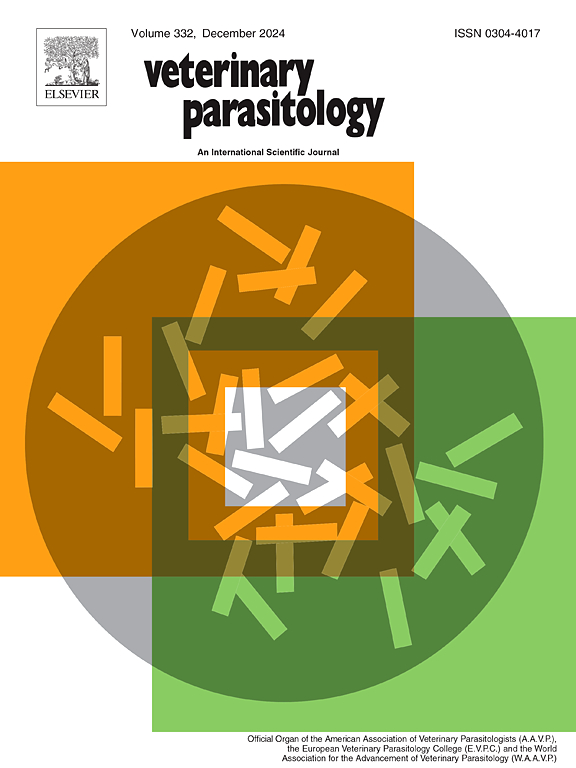Leishmania sp. can affect the cardiovascular system of dogs – A systematic review of over 80 years
IF 2
2区 农林科学
Q2 PARASITOLOGY
引用次数: 0
Abstract
Cardiovascular involvement in Leishmania sp. infections still requires further elucidation, with cutaneous and organic changes being more frequently observed. The aim of this study was to conduct a systematic review of cardiovascular involvement in dogs with canine visceral leishmaniasis, considering a publication span of over 80 years. A bibliographic search focused on canine visceral leishmaniasis and cardiovascular involvement via the descriptors “leishmaniasis,” “heart,” and “dogs” from 1940 to 2024. An analysis of over 80 years of published documents was performed across four databases: PubMed, Web of Science, Scopus, and Portal Capes. The inclusion and exclusion criteria were predetermined to ensure proper triage, considering documents that described cardiovascular involvement in canine visceral leishmaniasis. Initially, 250 documents were identified via the specified descriptors. After applying the inclusion and exclusion criteria, 29 articles were deemed eligible. Most studies were dated from 2005 to 2024. Histopathological analysis of heart samples was performed in nearly 20 studies. The animals evaluated were over 6 months old, with Leishmania infantum being the most frequently described species. Cardiovascular alterations were observed from electrophysiological, echocardiographic, and histopathological/immunohistochemical perspectives and in biomarker concentrations. Canine visceral leishmaniasis has extensive dissemination potential, emphasizing the need for veterinary and epidemiological surveillance services to monitor the spatial/temporal patterns of this disease. Cases of myocarditis with inflammatory infiltrates were documented in all reviewed studies. Routine cardiovascular evaluation should be integrated into the assessment and monitoring of canine visceral leishmaniasis, considering clinical, laboratory, and imaging evidence of cardiovascular alterations.
利什曼原虫可以影响狗的心血管系统-一项超过80年的系统综述
利什曼原虫感染对心血管的影响仍需进一步阐明,皮肤和器质性的改变更常被观察到。本研究的目的是对患有犬内脏利什曼病的狗的心血管疾病进行系统回顾,考虑到发表时间超过80年。通过1940年至2024年的描述词“利什曼病”、“心脏”和“狗”,对犬内脏利什曼病和心血管疾病进行了书目搜索。通过四个数据库(PubMed、Web of Science、Scopus和Portal Capes)对80多年来发表的文件进行了分析。纳入和排除标准是预先确定的,以确保适当的分类,考虑到文献描述心血管累及犬内脏利什曼病。最初,通过指定的描述符确定了250个文档。在应用纳入和排除标准后,29篇文章被认为符合条件。大多数研究的日期是2005年至2024年。近20项研究对心脏样本进行了组织病理学分析。被评估的动物均超过6个月大,其中幼利什曼原虫是最常被描述的物种。从电生理、超声心动图、组织病理学/免疫组织化学角度和生物标志物浓度观察心血管改变。犬内脏利什曼病具有广泛的传播潜力,强调需要兽医和流行病学监测服务来监测这种疾病的时空格局。所有回顾的研究都记录了伴有炎症浸润的心肌炎病例。考虑到心血管改变的临床、实验室和影像学证据,应将常规心血管评估纳入犬内脏利什曼病的评估和监测中。
本文章由计算机程序翻译,如有差异,请以英文原文为准。
求助全文
约1分钟内获得全文
求助全文
来源期刊

Veterinary parasitology
农林科学-寄生虫学
CiteScore
5.30
自引率
7.70%
发文量
126
审稿时长
36 days
期刊介绍:
The journal Veterinary Parasitology has an open access mirror journal,Veterinary Parasitology: X, sharing the same aims and scope, editorial team, submission system and rigorous peer review.
This journal is concerned with those aspects of helminthology, protozoology and entomology which are of interest to animal health investigators, veterinary practitioners and others with a special interest in parasitology. Papers of the highest quality dealing with all aspects of disease prevention, pathology, treatment, epidemiology, and control of parasites in all domesticated animals, fall within the scope of the journal. Papers of geographically limited (local) interest which are not of interest to an international audience will not be accepted. Authors who submit papers based on local data will need to indicate why their paper is relevant to a broader readership.
Parasitological studies on laboratory animals fall within the scope of the journal only if they provide a reasonably close model of a disease of domestic animals. Additionally the journal will consider papers relating to wildlife species where they may act as disease reservoirs to domestic animals, or as a zoonotic reservoir. Case studies considered to be unique or of specific interest to the journal, will also be considered on occasions at the Editors'' discretion. Papers dealing exclusively with the taxonomy of parasites do not fall within the scope of the journal.
 求助内容:
求助内容: 应助结果提醒方式:
应助结果提醒方式:


